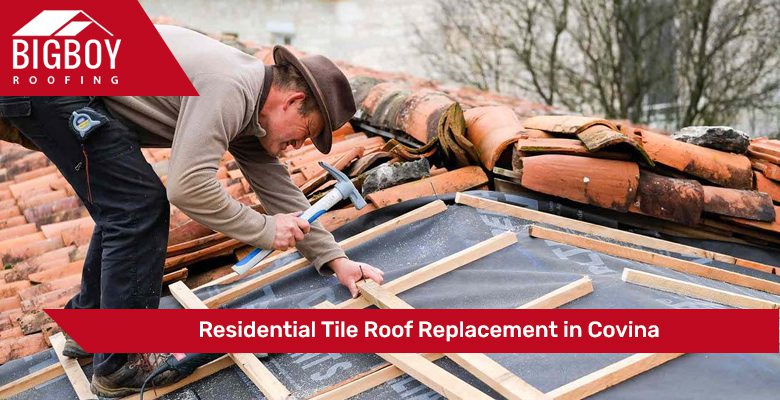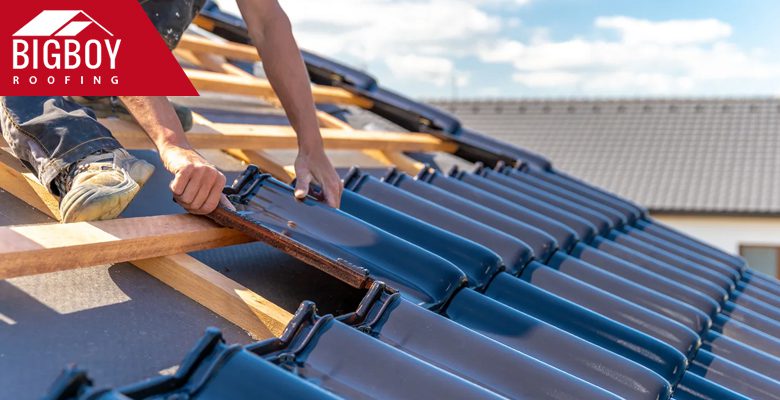Residential Tile Roof Replacement
If you’re a homeowner looking to enhance the beauty and durability of your property, getting a residential tile roof replacement might be an option for you.

This article has gathered valuable insights and the essential information to guide you through getting a flawless tile roof replacement for your cherished abode. Read on to find out more.
Common Reasons for Residential Tile Roof Replacement
Here are some common reasons to schedule a residential tile roof replacement with our Covina roofing experts today:
I. Age: Tile roofs have a long lifespan, typically 50 to 100 years. However, the tiles may become brittle, crack, or break as the roof ages.
II. Damage from weather events: Severe weather conditions such as hailstorms, high winds, or heavy rain can cause significant damage to tile roofs. Tiles may crack, chip, or become dislodged, leading to potential water infiltration and leaks.
III. Widespread tile deterioration: Over time, exposure to the elements and natural wear and tear can cause tile deterioration. This can manifest as cracking, chipping, or losing protective glaze.
IV. Roof leaks and water damage: Persistent leaks that cannot be effectively repaired may indicate underlying issues with the tile roof. If water penetrates through multiple areas or there is evidence of water damage, it may be a sign that the tiles, underlayment, or flashing are no longer providing adequate protection.
Causes of Residential Tile Roof Damage
Residential tile roofs are generally durable and long-lasting, but they can still be subject to damage under certain conditions. Here are some common causes:
| Causes | Description |
| Impact damage | Tile roofs can be vulnerable to damage from falling objects such as tree branches, debris, or hailstones. These impacts can cause tiles to crack, break, or become dislodged, compromising the roof’s integrity and potentially leading to water leaks. |
| Improper installation | If a tile roof is not installed correctly, it may be more prone to damage. Improperly fastened or secured tiles can be susceptible to displacement or lifting during storms. |
| Foot traffic and maintenance | Walking on a tile roof without proper precautions can cause tiles to crack or break. |
| Structural movement | Buildings naturally experience some degree of movement due to settling, expansion, or contraction. These movements can stress the tiles. |
How Is Residential Tile Roof Replacement Done?
Residential tile roof replacement by our roofing experts involves several steps to ensure a successful and proper installation. Here is a general overview of the process:

I. Inspection and preparation: The first step is thoroughly inspect the existing tile roof. A professional roofing contractor will assess the condition of the tiles, underlayment, flashing, and other components. They will identify any damaged or deteriorated areas that require replacement.
II. Tile selection: Once the inspection is complete, you must choose new tiles for your roof. Various types, styles, and colors are available to match your home’s aesthetics.
III. Removal of existing tiles: The old tiles are carefully removed, starting from the ridge and working downward. Special care is taken to prevent damage to the roof deck and underlying structures. Any damaged underlayment or flashing is also replaced at this stage.
IV. Repair and preparation: Any repairs to the roof deck or structure are carried out before installing the new tiles. This may involve replacing damaged wood or repairing sections that have deteriorated over time.
V. Underlayment installation: A high-quality underlayment is installed over the roof deck to protect against water infiltration. The underlayment acts as a barrier between the tiles and the roof deck.
VI. Flashing and trim installation: Metal flashing is installed around roof penetrations, such as chimneys, vents, and skylights, to ensure a watertight seal. Additionally, trim pieces are installed along the roof edges and ridges to provide a finished look and added protection.
VII. Tile installation: The new tiles are carefully positioned and secured using nails or screws. The installation follows a specific pattern and layout determined by the roof design. Each tile is aligned and interlocked with adjacent tiles to create a weatherproof barrier.
Book a roofing consultation with our contractors today!
Addressing roofing issues promptly can prevent further damage and potentially save you from costly repairs. By booking a consultation, you’ll gain insights into the condition of your roof and take proactive steps to protect your home.
FAQs
When must a residential tile roof replacement be considered?
It’s time to consider a tile roof replacement when your roof shows signs of significant damage, leaks persist despite repairs, or the tiles are aged and worn beyond repair.
How long do tile roofs typically last?
Tile roofs are known for longevity and can last 50 to 100 years or more with proper maintenance.
What are the advantages of choosing a tile roof replacement?
Tile roofs offer excellent durability, fire resistance, and resistance to pests. They also provide a classic and elegant appearance, enhance curb appeal, and are available in various styles and colors.
Do I need to reinforce my roof structure for a tile roof replacement?
Tile roofs are heavier than other roofing materials, so it’s essential to have the roof structure inspected to ensure it can support the added weight. In some cases, reinforcement may be necessary.

